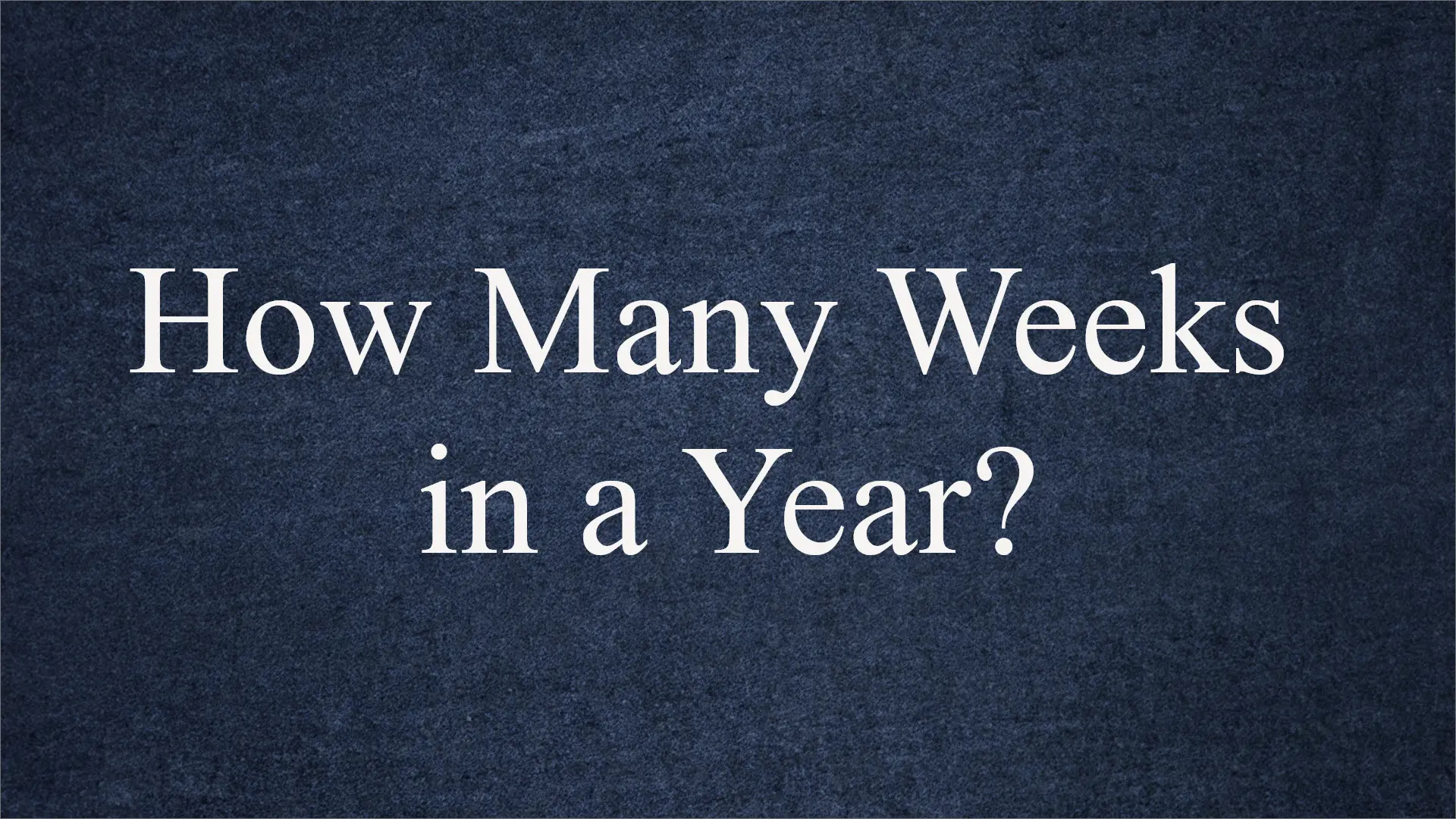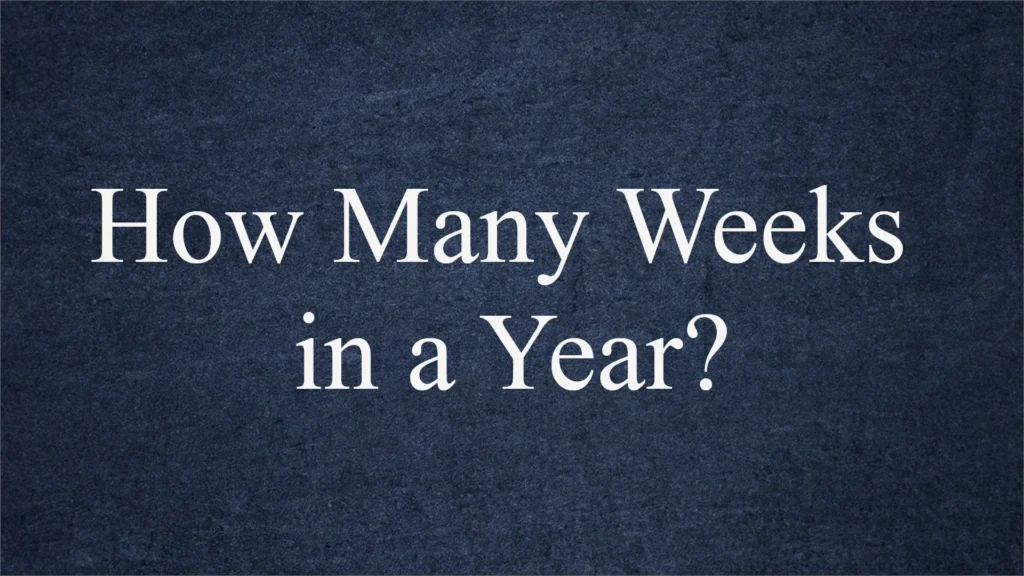
How Many Weeks in a Year? Simple Online Calculation

Imagine the incredible mosaic of time that calendars help us piece together—guiding us through the rhythmic dance of days, months, and years since ancient times. Now, right at the heart of this temporal journey, let’s shine a light on a simple yet fascinating concept: the weeks within a year. It’s like that cozy nook of time that we often take for granted, but it’s more important than we might think!
So, in this blog post, get ready to unwrap the mystery as we journey through different calendar systems, play around with some math, and discover the amazing ways weeks influence our daily lives, cultures, and festivities.
Join the adventure to answer the quirky question, “How many weeks in a year?” Delightfully immersing ourselves in the vibrant tapestry that intertwines our schedules, narratives, and the eternal nature of time!
Online Time Calculator - MSF Blog
Weeks in a Year? Simple Calculation
There are approximately 52.143 weeks in a year. To calculate this, you can use the following formula:
365 days (in a non-leap year) / 7 days per week = 52.143 weeks
This calculation assumes a standard year with 365 days. In a leap year, which occurs every four years, there are 366 days, so there would be an extra week, totaling approximately 52.286 weeks in that year. However, the difference is relatively small and often rounded to 52 weeks for simplicity in many practical contexts.
Standard Year and Weeks
Ah, the Gregorian calendar! It’s like the rockstar of calendars, the one that rules most of our lives. So, picture this: it’s got 12 months, each with its own charm and vibe, and these months house varying numbers of days, which can range from 28 to 31.
Now, to keep things delightfully organized, we’ve got weeks. Yes, those little bundles of time that give structure to our busy lives. Each week is a neat package of 7 days, like Monday blues, midweek hump days, and those sweet, sweet weekends we all love. They’re the mini-cycles within the big cycle of a year.
So, while we’re exploring the ins and outs of weeks, let’s not forget to give a shout out to the Gregorian calendar for being the superstar that keeps our lives ticking!
Calculating Weeks in a Year
Let’s do some calendar math! A standard year in the Gregorian calendar has 365 days (excluding leap years), and there are 7 days in a week. If we divide 365 by 7, we get approximately 52 weeks with a few days left over.
Now, here’s the twist: the months have varying days—30, 31, and even 28 or 29 for February in a leap year. This variability creates extra days that don’t fit neatly into weeks.
For example, a month with 30 days leaves 2 days extra, while a month with 31 days leaves 3. When you add up these leftovers, they mess with our clean 52-week calculation. It’s a reminder that while the math might seem straightforward, real-life calendars can be delightfully irregular!
How Many Weeks in a Gregorian Year?
So, after all the calendar math and juggling irregular months, let’s get to the bottom line. A standard year in the Gregorian calendar, with its 365 days (excluding leap years), gives us a ballpark of around 52 weeks.
This means that if you’re looking at the entire year as a big puzzle made of weeks, you’d find about 52 complete weeks and some days that don’t quite fit.
Weeks in Leap Years and Their Impact
Now, let’s talk about those special years that throw a twist into our calendar calculations: leap years! Imagine Earth’s journey around the sun as a marathon—it’s about 365.24 days, not exactly 365. To make up for this extra fraction of a day, we have leap years.
i. Determining Leap Years
Leap years follow a rule to keep our calendars from drifting out of sync. Most years are regular, with 365 days, but a leap year has an extra day—366 days in total.
Here’s the rule: a year is a leap year if it’s divisible by 4. But wait, there’s a catch! If a year is divisible by 100 but not by 400, it’s not a leap year.
Got it? So, 2000 was a leap year because it’s divisible by 400, but 1900 wasn’t because it’s divisible by 100 but not by 400.
ii. Impact on Days and Weeks in a Year
Now, what does all this leap year magic mean for days and weeks? Well, that extra day in a leap year means a slight shift in the calendar. It’s like the Earth taking a cosmic leap day.
This shift doesn’t affect weeks much—there are still about 52 weeks in a year, but the days of the week will be one day later than the previous year.
Variations in Calendars
Our journey through calendars wouldn’t be complete without a glimpse into the rich tapestry of timekeeping across cultures.
While the Gregorian calendar is the star of the show, there are other fascinating calendars that add their own flair to the passage of time.
i. Lunar Calendars
Imagine a calendar based on the phases of the moon—a lunar calendar. It’s not synchronized with the solar year, so it drifts over time. Islamic, Hebrew, and Chinese calendars are examples.
Lunar months are shorter, around 29 or 30 days, leading to about 354 or 384 days in a year. This means the number of weeks in these calendars can vary widely from year to year.
ii. Julian Calendar
Before the Gregorian calendar, there was the Julian calendar. It has 365 days with a leap year every 4 years but without the refined “divisible by 100 but not 400” rule.
This small difference led to a slow drift from the solar year, ultimately prompting the switch to the Gregorian calendar. Julian years could have slightly more or fewer weeks than our familiar 52.
Fun Facts About Yearly Calendars
Lets explore some amazing fun facts about the yearly calendars :
i. Lost Days in the Gregorian Calendar Shift
When Pope Gregory XIII introduced the Gregorian calendar in 1582 to fix the discrepancy between calendar days and astronomical events, some countries skipped ahead by 10 days!
Imagine going to bed on October 4 and waking up on October 15—talk about a leap in time!
ii. February's One-Time Dilemma
Sweden decided to switch from the Julian to the Gregorian calendar in 1753, but to do so, they needed to remove a whopping 11 days from February.
So, in Sweden, the year 1753 had a February 17 followed by a March 1. Now, that’s a calendar makeover!
iii. Lost Weeks in the French Revolution
During the French Revolution, the calendar was revamped to emphasize decimal divisions and secularism. The new calendar had 12 months of 30 days each, plus 5 or 6 additional days at the end of the year for celebrations.
This led to shorter weeks and, in turn, shorter work cycles—a novelty that wasn’t entirely embraced.
iv. Moon's Influence
In the Hebrew calendar, months follow lunar phases, making it shorter than the Gregorian year. To keep things aligned, the Hebrew calendar adds a leap month every 2 or 3 years! It’s like giving time a little moonlit nudge.
v. Leap Second Jumps
Just like leap years, there are leap seconds. Occasionally, timekeepers add a second to Coordinated Universal Time (UTC) to keep atomic clocks and Earth’s rotation in sync. It’s like Earth’s way of saying, “Wait, I need a bit more time!”
Final Remarks - Weeks in a Year
As we bid adieu to this calendar journey, let’s recap the gems we’ve uncovered. From the Gregorian calendar’s 365 days and approximately 52 weeks to the delightful complexity of leap years, we’ve unraveled time’s tapestry.
Variations like lunar calendars and historical shifts offer a reminder that time’s rhythm varies across cultures. Through historical anecdotes and fun facts, we’ve seen how calendars shape history and society. Calendars are more than tools; they’re cultural, scientific, and practical treasures that weave through our lives. In our fast-paced world, where days blur together, let’s remember the marvel of calendars that keep our stories and celebrations in sync.
So, why not take a leap into the captivating history and mechanics of timekeeping? The calendars of the world are waiting to share their tales, and the exploration promises to be as rich as the passing of days themselves.
Author



